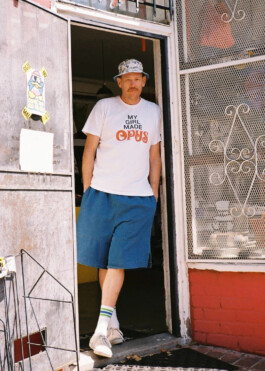
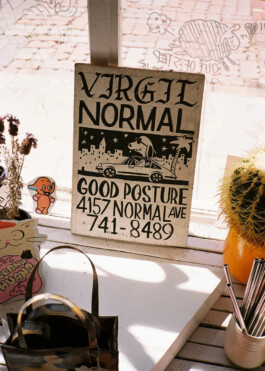
Virgil Normal
Step into Virgil Normal on the east side of L.A., and you'll likely be greeted by Charlie Staunton, the store's owner (alongside Shirley Kurata), who grew up wearing oversized Dickies and skating in SoCal. Charlie, an ex-member of the Latebirds moped gang, took over the old Choke space in 2015 and has since been serving up an eclectic mix of apparel and home goods for the discerning eye. If you're in the neighborhood, go say hi—you'll be made to feel so, so good.
You grew up in SoCal and were into skating, surfing, and snowboarding. Were you getting into trouble, just having fun, or a bit of both?
Growing up in the burbs, we took advantage of smooth sidewalks and lax school security. We could skate anywhere we wanted. At most, a security guard in a golf cart would chase us, but we’d just go to another spot on campus. The local 7-11 was super cool. We would roll our launch ramp over, put it up against the wall, and do wall rides for hours. They never called the cops or kicked us out. Thanks, dudes. So no, I didn’t get in much trouble. One of my biggest regrets now is that I never broke an arm or a femur. I guess I wasn’t trying hard enough.
What kind of apparel were you rocking back then?
My first foray into fashion (I’m dating myself) was Jimmy’z. I was obsessed, had as many pairs of pants, shorts, and shirts as I could get my hands on. I am now friends with Jimmy’z daughter and got to go to his house once. Super cool dude. Unfortunately, he had hardly any archives of his stuff. Then the local skate shop started carrying Stussy, and that was it. I was dripping in Stussy and would scribble the logo on all my papers. Then XLarge, Blind, and going to Doughboys in Bellflower wearing super-sized Dickies and Carhartt jackets. And then, my mom showed me how to sew, so I started putting two pairs of pants together (just the legs) so when I’d go snowboarding, you could not see my boots or bindings. Really wide stuff.
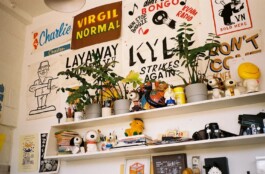
“The local 7-11 was super cool. We would roll our launch ramp over, put it up against the wall, and do wall rides for hours. They never called the cops or kicked us out. Thanks, dudes.”
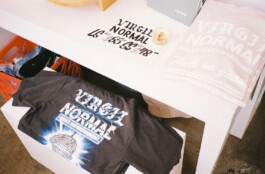
You received a BFA in Fine Arts at Cal State Long Beach. What kind of work were you producing during that time?
I made stuff as big as I could. Mostly installation art, giant litho print photos that I would hang so they could layer the images as they were transparent. Think a 6-foot-tall photo negative, but it was positive. We would also host “performance art parties” at our studio on a monthly basis, so those ran the gamut of spoken word to jazz, social justice, and a touch of BDSM. But largely, the subject of my work was the male gaze, which I turned on myself. So there was some conceptual striptease going on.
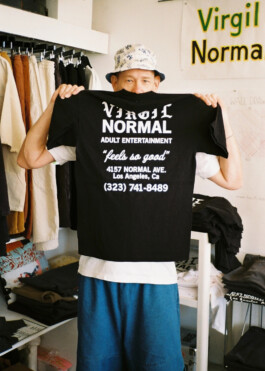
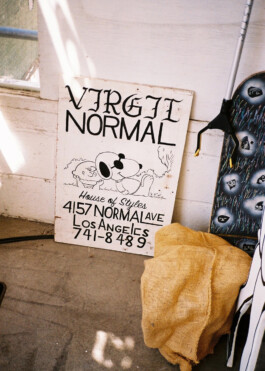
Did you discover photography around then as well?
Yeah, I was really into graphic design before that, but I went to MOCA and Sigmar Polke was having a show. He traveled around taking pics in Afghanistan and the countryside of Germany. He had a barn that was his dark room, and would get high on mushrooms and print large-scale. He’d also montage images together. Then he wouldn’t fix the prints too well, so they would almost tie-dye brown and yellow and become abstract. They would end up having more to do with Ed Moses paintings than any dialogue going on in photography. He was a huge influence on me, and some of my professors did not dig that.
What's your favorite point-and-shoot camera right now?
Oh gosh, I’m obsessed with the Pentax 110 Auto.
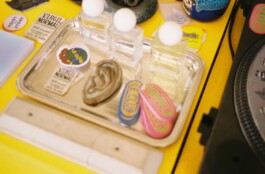
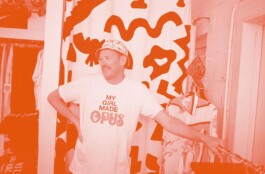
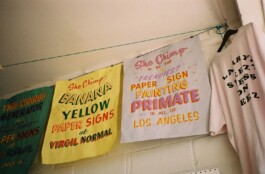
When did you get into apparel design?
Sometime around 2000, I was a waiter and doing windows for a store on Melrose, and assisting other photographers, as well as trying to get a book together to be a photographer. Then my friend Rob, who I met in illustration class, said he had a position working for a girls' surf brand.
Did you have your own collection?
My friend Rob and I went on to create a label called Brown Sound, inspired by the May 1968 riots and, of course, the Situationists International. We did 12 seasons together.
“It started out, and pretty much remains, a gallery of our friends' creative deeds.”
What was happening in Studio Zumbido?
Besides living underneath my photo enlarger, we had monthly art parties. Our neighbors ranged from other artists to electricians and tweakers who had over 100 cats. All of them had six paws.
When did you conceive of Virgil Normal, and what was the concept behind the store and your own label?
In the spring of 2015, our good friend Jeff, who ran Choke, a moped shop out of here, was moving on to pursue a career as a stuntman. Shirley and I had been hanging out here since 2006, loved the space and the neighbors, so we asked him to take us to his landlord. Both of us, being involved in clothing and knowing folks, just started making calls and seeing what we could fill the store with as soon as possible. It started out, and pretty much remains, a gallery of our friends' creative deeds.
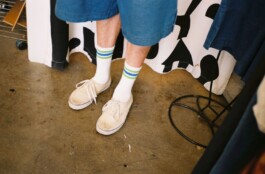
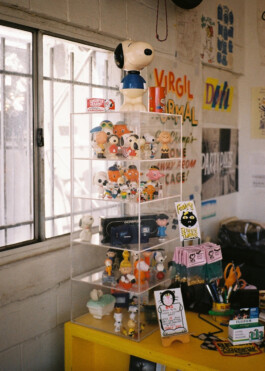
What are a few of your favorite brands that you carry?
Super stoked on Meals, a fun brand where shape and volume is everything. Posture, an eclectic and ever-changing creative process by Theophilus Martins. Sometimes it’s cool, clean, classic clothing, and sometimes he’s making cereal or music. He’s been our bud since day one.
The store used to be the old Choke moped shop, correct? And you formed the Los Angeles Latebirds moped gang with Shirley Kurata, Rob Sinclair, and Jennifer Anderson?
That is true.I know you're a keen cyclist. When did that passion start, and what are you riding right now?
My friend Jeff gave me a bike when he moved away, but it was too small for me. Luckily, we had a neighbor named Ben who was really inspiring. He was either riding bikes or skateboarding but wasn’t preachy about it. I finally got a bike that fit me, and he was so encouraging and patient. He waited so long for me to climb hills, catch my breath, and drink gallons of water. Looking back now, I can’t believe how kind he and Mikey were. I’m still riding hills with Mikey, but Ben moved back to San Francisco, so I only get to ride with him every once in a while. But we still keep in touch and say we’ll ride together again someday.
Still catching any waves?
I wish.

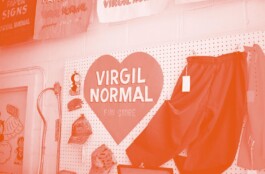
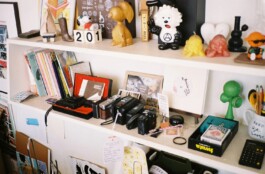
It looks like you have a pretty vast collection of Snoopy figures in the store?
Yup, just tell people you like Snoopy, and they will start finding them for you. It’s almost entirely gifted. I’m saving them as my retirement fund.
Who made all of the hand-painted signs?
The world-famous Shela, aka She Chimp. If you need one, visit shechimppapersigns.com—she ships!
I love the Virgil Normal ‘It Ain’t Formal’ video.
Oh yeah, what a trip. Naomi Yang did that. I was totally fanboying out when she and Damon came into the shop. They were in Galaxie 500, one of the coolest bands ever, and they wanted to play dress-up with me. Crazy! Anyway, she makes videos and does photography now and was going to be here in Los Angeles for a few weeks. We talked about putting all the characters that creep around the shop into it. And then walks in Stephen Merritt, aka The Magnetic Fields—the dude behind 69 Love Songs, the greatest triple album of all time. If you have a broken heart, just put this on repeat. We chatted a bit, he took notes, and then Naomi and Damon picked Shirley and me up that evening to go see The Magnetic Fields play at UCLA. She played me a rough cut of the song. My mind was blown. So yeah, thank you, Naomi, love you big time.
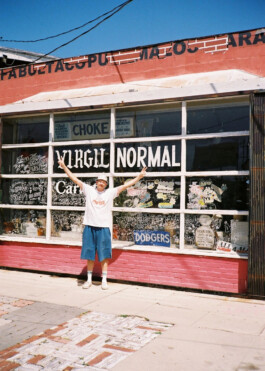
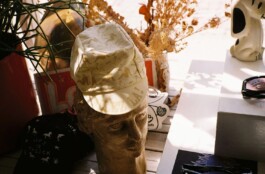

Virgil Normal

Step into Virgil Normal on the east side of L.A., and you'll likely be greeted by Charlie Staunton, the store's owner (alongside Shirley Kurata), who grew up wearing oversized Dickies and skating in SoCal. Charlie, an ex-member of the Latebirds moped gang, took over the old Choke space in 2015 and has since been serving up an eclectic mix of apparel and home goods for the discerning eye. If you're in the neighborhood, go say hi—you'll be made to feel so, so good.
You grew up in SoCal and were into skating, surfing, and snowboarding. Were you getting into trouble, just having fun, or a bit of both?
Growing up in the burbs, we took advantage of smooth sidewalks and lax school security. We could skate anywhere we wanted. At most, a security guard in a golf cart would chase us, but we’d just go to another spot on campus. The local 7-11 was super cool. We would roll our launch ramp over, put it up against the wall, and do wall rides for hours. They never called the cops or kicked us out. Thanks, dudes. So no, I didn’t get in much trouble. One of my biggest regrets now is that I never broke an arm or a femur. I guess I wasn’t trying hard enough.
What kind of apparel were you rocking back then?
My first foray into fashion (I’m dating myself) was Jimmy’z. I was obsessed, had as many pairs of pants, shorts, and shirts as I could get my hands on. I am now friends with Jimmy’z daughter and got to go to his house once. Super cool dude. Unfortunately, he had hardly any archives of his stuff. Then the local skate shop started carrying Stussy, and that was it. I was dripping in Stussy and would scribble the logo on all my papers. Then XLarge, Blind, and going to Doughboys in Bellflower wearing super-sized Dickies and Carhartt jackets. And then, my mom showed me how to sew, so I started putting two pairs of pants together (just the legs) so when I’d go snowboarding, you could not see my boots or bindings. Really wide stuff.


“The local 7-11 was super cool. We would roll our launch ramp over, put it up against the wall, and do wall rides for hours. They never called the cops or kicked us out. Thanks, dudes.”


You received a BFA in Fine Arts at Cal State Long Beach. What kind of work were you producing during that time?
I made stuff as big as I could. Mostly installation art, giant litho print photos that I would hang so they could layer the images as they were transparent. Think a 6-foot-tall photo negative, but it was positive. We would also host “performance art parties” at our studio on a monthly basis, so those ran the gamut of spoken word to jazz, social justice, and a touch of BDSM. But largely, the subject of my work was the male gaze, which I turned on myself. So there was some conceptual striptease going on.



When did you get into apparel design?
Sometime around 2000, I was a waiter and doing windows for a store on Melrose, and assisting other photographers, as well as trying to get a book together to be a photographer. Then my friend Rob, who I met in illustration class, said he had a position working for a girls' surf brand.
Did you have your own collection?
My friend Rob and I went on to create a label called Brown Sound, inspired by the May 1968 riots and, of course, the Situationists International. We did 12 seasons together.
“It started out, and pretty much remains, a gallery of our friends' creative deeds.”
What was happening in Studio Zumbido?
Besides living underneath my photo enlarger, we had monthly art parties. Our neighbors ranged from other artists to electricians and tweakers who had over 100 cats. All of them had six paws.
When did you conceive of Virgil Normal, and what was the concept behind the store and your own label?
In the spring of 2015, our good friend Jeff, who ran Choke, a moped shop out of here, was moving on to pursue a career as a stuntman. Shirley and I had been hanging out here since 2006, loved the space and the neighbors, so we asked him to take us to his landlord. Both of us, being involved in clothing and knowing folks, just started making calls and seeing what we could fill the store with as soon as possible. It started out, and pretty much remains, a gallery of our friends' creative deeds.


What are a few of your favorite brands that you carry?
Super stoked on Meals, a fun brand where shape and volume is everything. Posture, an eclectic and ever-changing creative process by Theophilus Martins. Sometimes it’s cool, clean, classic clothing, and sometimes he’s making cereal or music. He’s been our bud since day one.
The store used to be the old Choke moped shop, correct? And you formed the Los Angeles Latebirds moped gang with Shirley Kurata, Rob Sinclair, and Jennifer Anderson?
That is true.I know you're a keen cyclist. When did that passion start, and what are you riding right now?
My friend Jeff gave me a bike when he moved away, but it was too small for me. Luckily, we had a neighbor named Ben who was really inspiring. He was either riding bikes or skateboarding but wasn’t preachy about it. I finally got a bike that fit me, and he was so encouraging and patient. He waited so long for me to climb hills, catch my breath, and drink gallons of water. Looking back now, I can’t believe how kind he and Mikey were. I’m still riding hills with Mikey, but Ben moved back to San Francisco, so I only get to ride with him every once in a while. But we still keep in touch and say we’ll ride together again someday.
Still catching any waves?
I wish.



It looks like you have a pretty vast collection of Snoopy figures in the store?
Yup, just tell people you like Snoopy, and they will start finding them for you. It’s almost entirely gifted. I’m saving them as my retirement fund.
Who made all of the hand-painted signs?
The world-famous Shela, aka She Chimp. If you need one, visit shechimppapersigns.com—she ships!
I love the Virgil Normal ‘It Ain’t Formal’ video.
Oh yeah, what a trip. Naomi Yang did that. I was totally fanboying out when she and Damon came into the shop. They were in Galaxie 500, one of the coolest bands ever, and they wanted to play dress-up with me. Crazy! Anyway, she makes videos and does photography now and was going to be here in Los Angeles for a few weeks. We talked about putting all the characters that creep around the shop into it. And then walks in Stephen Merritt, aka The Magnetic Fields—the dude behind 69 Love Songs, the greatest triple album of all time. If you have a broken heart, just put this on repeat. We chatted a bit, he took notes, and then Naomi and Damon picked Shirley and me up that evening to go see The Magnetic Fields play at UCLA. She played me a rough cut of the song. My mind was blown. So yeah, thank you, Naomi, love you big time.

